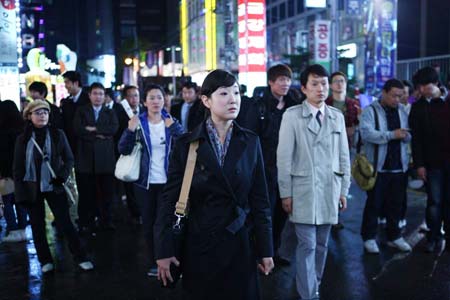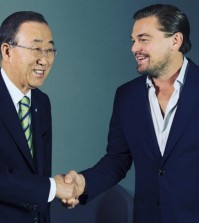- California Assembly OKs highest minimum wage in nation
- S. Korea unveils first graphic cigarette warnings
- US joins with South Korea, Japan in bid to deter North Korea
- LPGA golfer Chun In-gee finally back in action
- S. Korea won’t be top seed in final World Cup qualification round
- US men’s soccer misses 2nd straight Olympics
- US back on track in qualifying with 4-0 win over Guatemala
- High-intensity workout injuries spawn cottage industry
- CDC expands range of Zika mosquitoes into parts of Northeast
- Who knew? ‘The Walking Dead’ is helping families connect
Korea emerges as film location spot
Hallyu boom, incentives attract foreign filmmakers

This scene from “The Bourne Legacy” was filmed at subway stations in the Gangnam area, southern Seoul. (Korea Times file)
By Chung Ah-young
When Hollywood spy movie “The Bourne Legacy” starring Jeremy Renner was released in 2012, Korean moviegoers quickly recognized subway stations used as locations in the Gangnam area, southern Seoul. Many Koreans found themselves attached to the film while other foreign viewers might have developed interest or curiosity about the capital through it.
“The Bourne Legacy” was the first Hollywood feature film shot in Seoul. In the past, Seoul had less exposure in foreign productions than other Asian cities such as Tokyo, Beijing and Shanghai. Not only Seoul but other cities such as Busan are attracting a growing number of foreign filmmakers in recent years.
The increasing attention on the nation as a location for film shoots is mainly derived from the steep growth of the Korean film market which has become the world’s fifth largest motion picture industry, drawing 200 million viewers last year.
The use of film locations in Korea has also been attributed to the hallyu craze in some sense which has made several foreign production companies look to the nation for their cinematic projects.
According to the Seoul Film Commission, “Hello, Stranger,”a Thai romantic comedy, is a case in point. Some 90 percent of its scenes were shot in downtown Seoul. The film scored a big success in the Thai movie market, ranking third place in its 2010 box office, probably because hallyu fans are interested in Korea. Other movies from Filipino and Malaysian production companies were filmed in Seoul, reflecting the hallyu spillover effect in the film industry.
Also, Busan, the nation’s second largest city, is emerging as Asia’s “Hollywood” because of the growing influence it has from the annual Busan International Film Festival (BIFF). Neighboring nations such as Japan and China are gaining easy access to the city for the film location spots.
The Busan Film Commission supports Busan-based foreign productions, while renovating the Busan Film Studio, which contains two shooting lots, to help them work for digital shooting, motion capture and high-end post-production.
Aside from the regional commissions, the Korean Film Council (KOFIC) has offered support for the foreign shoots in Korea with location incentive programs since 2011.
The location incentives support part of the expenses of foreign feature films and television drama series shot in Korea. KOFIC offers up to 30 percent cash grant on foreign audio-visual works production expenditure incurred for goods and services in Korea, with a cap of 2.6 billion won (approximately $2.6 million). The governmental support comes from the Tourism Promotion and Development Fund. KOFIC runs the English-language website (koreafilm.or.kr) to provide information about local film companies and crews for foreign producers.
With the introduction of open, transparent information, the government hopes that the nation will become a more accessible destination for foreign filmmakers.
Production facilities such as film studios in Seoul, Busan, Bucheon and Jeonju provide shooting locations that can be rented at low cost. KOFIC is closely cooperating with other regional film commissions such as Seoul, Incheon, Gyeonggi Province with their own services and subsidies.
Under the incentive program, KOFIC has supported Chinese feature films “On the Road” and “Urban Games,” “Beyond the Border,” an American feature film, and “Hakuji no Hito,” a Japanese feature film, alongside “Rainbow Rose,” a Japanese TV series.
According to the film industry insiders, “The Avengers 2: Age of Ultron” will possibly be shot in Korea as Marvel Productions has scouted locations in London, South Africa and Korea, along with the likely casting of a Korean actress as a villain in the new film.
The U.S.-based film studio has yet to fix the final locations and actor Mark Ruffalo (Incredible Hulk) responded to this report on Twitter by commenting, “No plan at this moment for ‘Avengers’ to shoot in Korea, but the Marvel universe is big” on Jan. 19.
But Korean sources claimed that it is highly likely to happen that Korea will be part of the shoot locations, given that director Joss Whedon announced that the film will be an international film and the soaring status of the Korean audience in the global film market.
Also, director Christopher McQuarrie visited Busan last year to look around the locations there for the possible filming of “Mission Impossible 5.”
The mounting interest of foreign filmmakers in Korea is a similar gesture of the recent rush of Hollywood mega stars. Last year, Hugh Jackman, Leonardo DiCaprio, Robert Downey Jr., Arnold Schwarzenegger and Tom Cruise chose Korea as a crucial destination to promote their films because the buying power of Korean moviegoers is getting strong enough to make foreign distributors concerned about their share in the market.
Their interest is shown in various ways such as participating in the production of Korean films or casting Korean actors in their movies.
Several Hollywood blockbusters such as “Iron Man 3,” “After Earth” and “Oblivion” had their global premiers in Seoul, indicative of the growing status of the Korean movie industry in the world. Robert Downey Jr. said “Korea has been one of the key markets for Iron Man,” during his visit to Seoul last year.
















